Causation and Effectuation: Addressing Management Issues in Business
VerifiedAdded on 2023/06/13
|7
|1952
|253
Essay
AI Summary
This essay examines the concepts of causation and effectuation as approaches to decision-making in the dynamic business environment of the 21st century. It contrasts causation, which focuses on pre-planned objectives and strategic planning to achieve them, with effectuation, which emphasizes leveraging available resources to explore various potential goals. The essay uses the example of U-Haul to illustrate these concepts, discussing how both causation and effectuation played roles in its development. It further details the principles of effectuation, including the Bird-in-Hand principle, Lemonade principle, Patchwork Quilt principle, Affordable Loss principle, and Pilot-in-the-Plane principle, and how these principles help entrepreneurs mitigate business management issues. The conclusion emphasizes the importance of understanding both causation and effectuation for effective decision-making and improved business performance in an uncertain and rapidly changing global market.
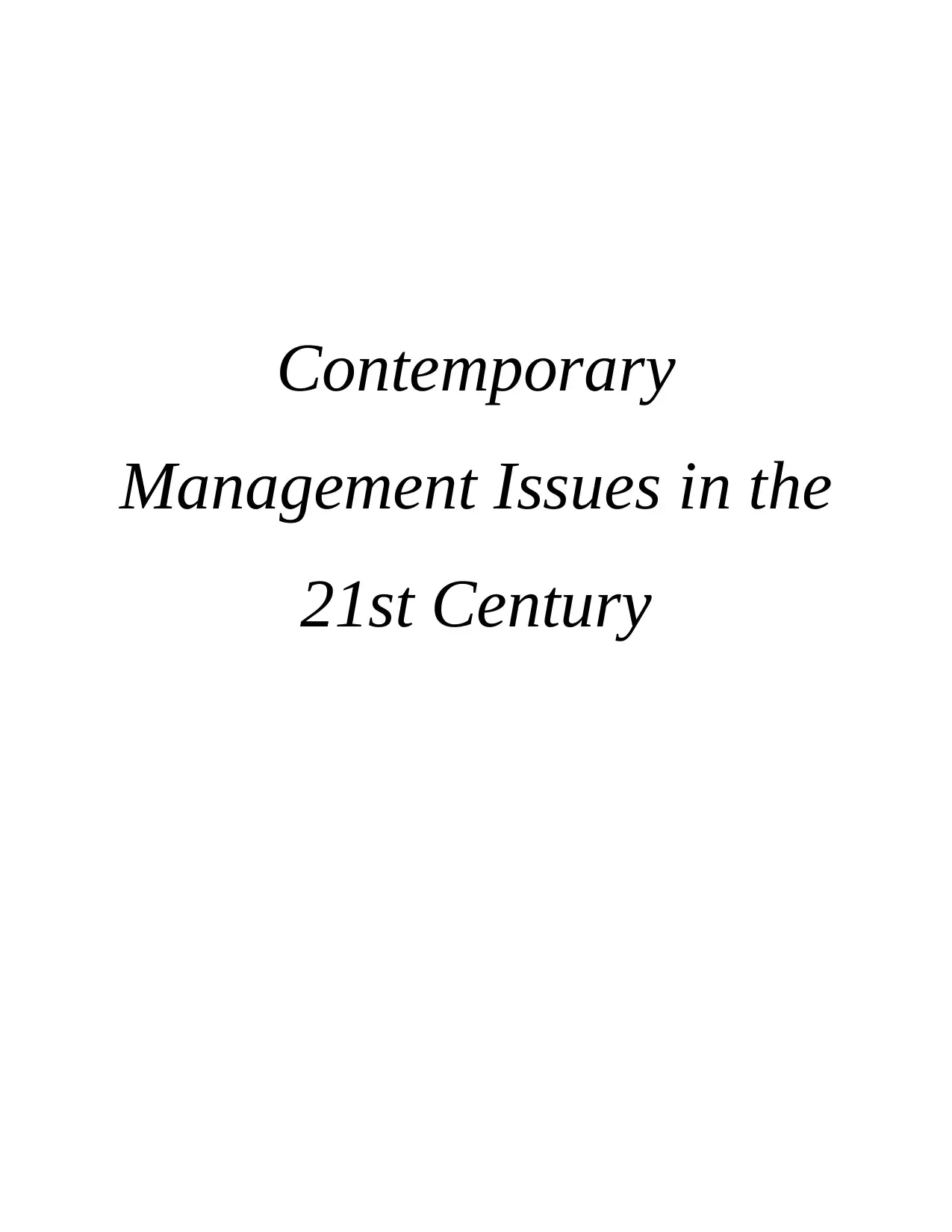
Contemporary
Management Issues in the
21st Century
Management Issues in the
21st Century
Paraphrase This Document
Need a fresh take? Get an instant paraphrase of this document with our AI Paraphraser

Contents
Contents...........................................................................................................................................2
INTRODUCTION...........................................................................................................................1
MAIN BODY..................................................................................................................................1
CONCLUSION................................................................................................................................4
REFERENCES................................................................................................................................5
Contents...........................................................................................................................................2
INTRODUCTION...........................................................................................................................1
MAIN BODY..................................................................................................................................1
CONCLUSION................................................................................................................................4
REFERENCES................................................................................................................................5
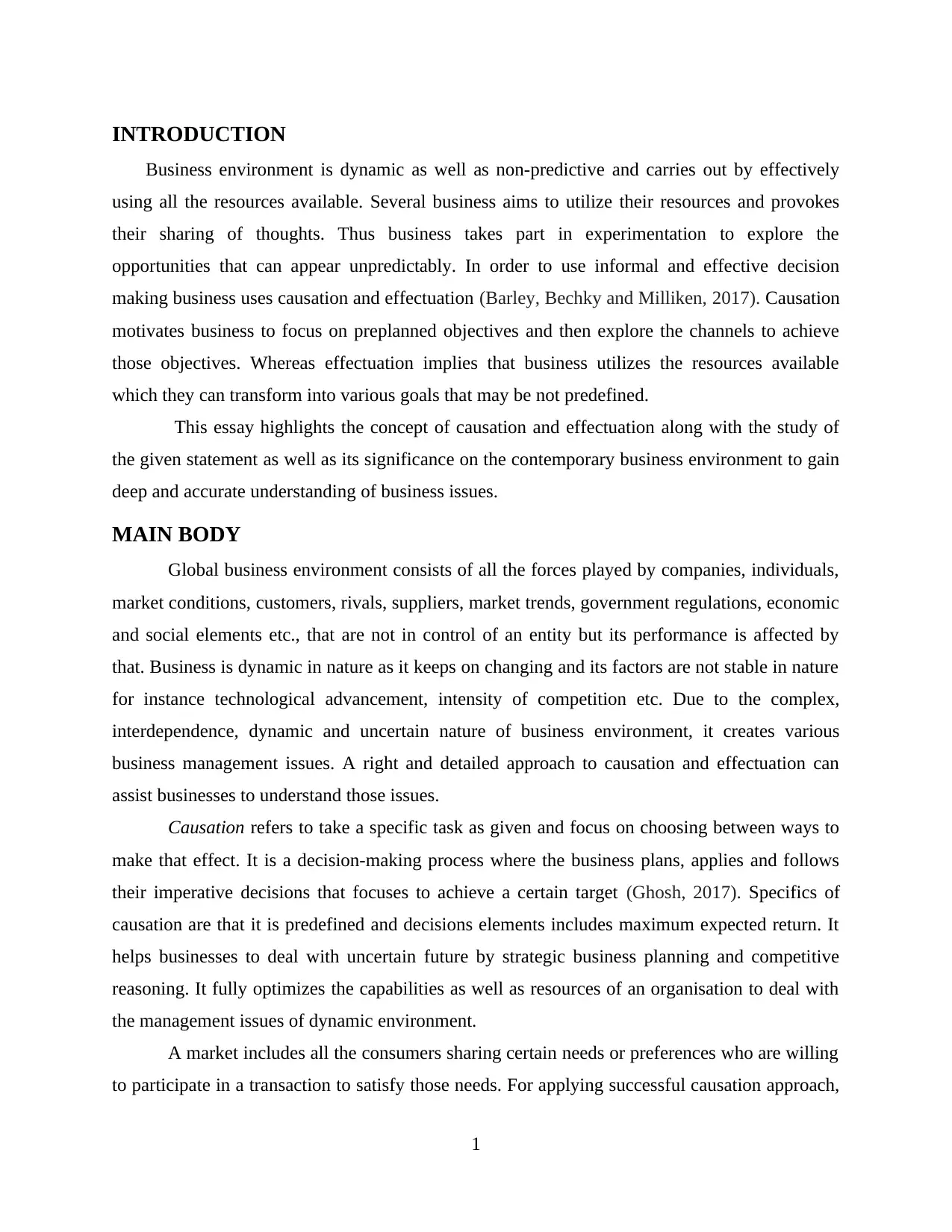
INTRODUCTION
Business environment is dynamic as well as non-predictive and carries out by effectively
using all the resources available. Several business aims to utilize their resources and provokes
their sharing of thoughts. Thus business takes part in experimentation to explore the
opportunities that can appear unpredictably. In order to use informal and effective decision
making business uses causation and effectuation (Barley, Bechky and Milliken, 2017). Causation
motivates business to focus on preplanned objectives and then explore the channels to achieve
those objectives. Whereas effectuation implies that business utilizes the resources available
which they can transform into various goals that may be not predefined.
This essay highlights the concept of causation and effectuation along with the study of
the given statement as well as its significance on the contemporary business environment to gain
deep and accurate understanding of business issues.
MAIN BODY
Global business environment consists of all the forces played by companies, individuals,
market conditions, customers, rivals, suppliers, market trends, government regulations, economic
and social elements etc., that are not in control of an entity but its performance is affected by
that. Business is dynamic in nature as it keeps on changing and its factors are not stable in nature
for instance technological advancement, intensity of competition etc. Due to the complex,
interdependence, dynamic and uncertain nature of business environment, it creates various
business management issues. A right and detailed approach to causation and effectuation can
assist businesses to understand those issues.
Causation refers to take a specific task as given and focus on choosing between ways to
make that effect. It is a decision-making process where the business plans, applies and follows
their imperative decisions that focuses to achieve a certain target (Ghosh, 2017). Specifics of
causation are that it is predefined and decisions elements includes maximum expected return. It
helps businesses to deal with uncertain future by strategic business planning and competitive
reasoning. It fully optimizes the capabilities as well as resources of an organisation to deal with
the management issues of dynamic environment.
A market includes all the consumers sharing certain needs or preferences who are willing
to participate in a transaction to satisfy those needs. For applying successful causation approach,
1
Business environment is dynamic as well as non-predictive and carries out by effectively
using all the resources available. Several business aims to utilize their resources and provokes
their sharing of thoughts. Thus business takes part in experimentation to explore the
opportunities that can appear unpredictably. In order to use informal and effective decision
making business uses causation and effectuation (Barley, Bechky and Milliken, 2017). Causation
motivates business to focus on preplanned objectives and then explore the channels to achieve
those objectives. Whereas effectuation implies that business utilizes the resources available
which they can transform into various goals that may be not predefined.
This essay highlights the concept of causation and effectuation along with the study of
the given statement as well as its significance on the contemporary business environment to gain
deep and accurate understanding of business issues.
MAIN BODY
Global business environment consists of all the forces played by companies, individuals,
market conditions, customers, rivals, suppliers, market trends, government regulations, economic
and social elements etc., that are not in control of an entity but its performance is affected by
that. Business is dynamic in nature as it keeps on changing and its factors are not stable in nature
for instance technological advancement, intensity of competition etc. Due to the complex,
interdependence, dynamic and uncertain nature of business environment, it creates various
business management issues. A right and detailed approach to causation and effectuation can
assist businesses to understand those issues.
Causation refers to take a specific task as given and focus on choosing between ways to
make that effect. It is a decision-making process where the business plans, applies and follows
their imperative decisions that focuses to achieve a certain target (Ghosh, 2017). Specifics of
causation are that it is predefined and decisions elements includes maximum expected return. It
helps businesses to deal with uncertain future by strategic business planning and competitive
reasoning. It fully optimizes the capabilities as well as resources of an organisation to deal with
the management issues of dynamic environment.
A market includes all the consumers sharing certain needs or preferences who are willing
to participate in a transaction to satisfy those needs. For applying successful causation approach,
1
⊘ This is a preview!⊘
Do you want full access?
Subscribe today to unlock all pages.

Trusted by 1+ million students worldwide
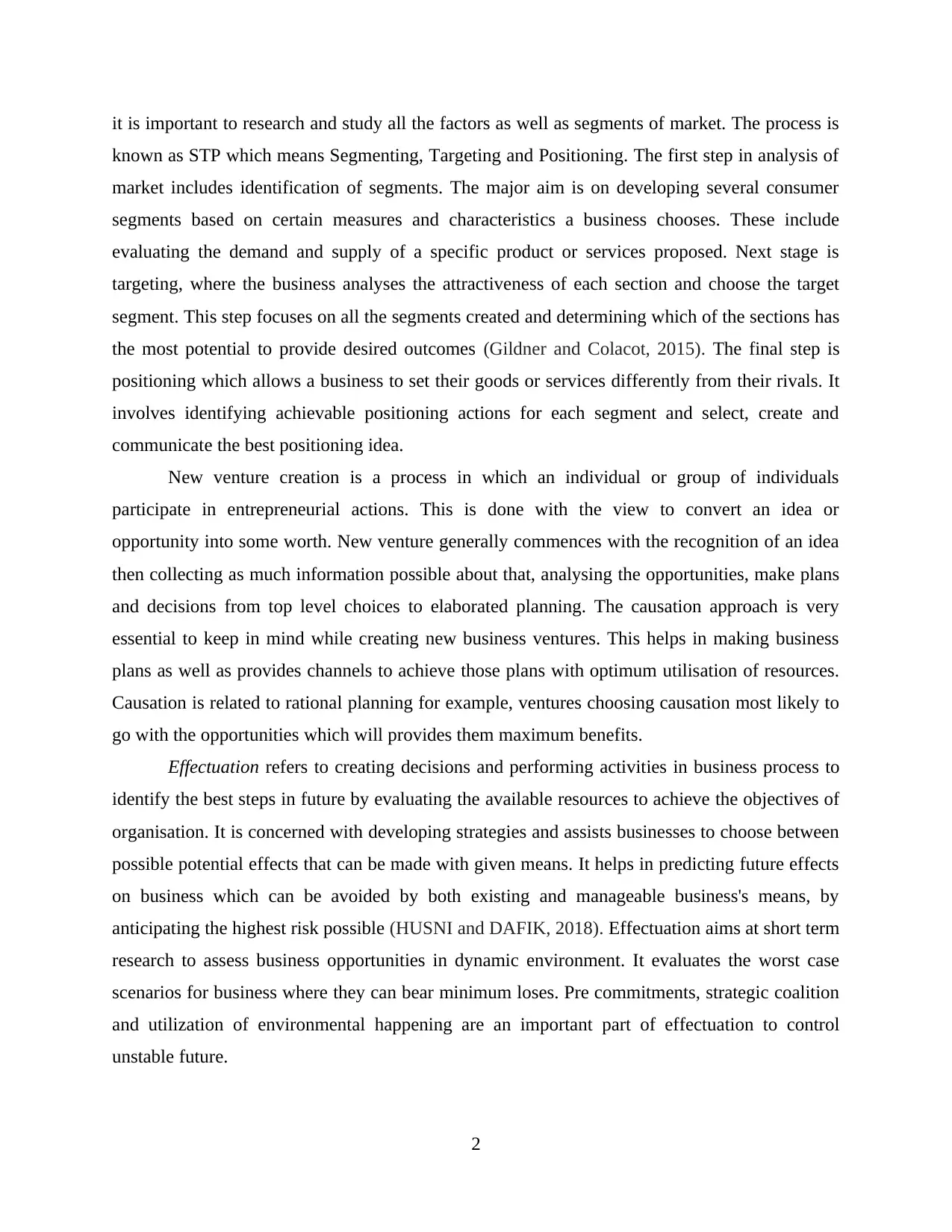
it is important to research and study all the factors as well as segments of market. The process is
known as STP which means Segmenting, Targeting and Positioning. The first step in analysis of
market includes identification of segments. The major aim is on developing several consumer
segments based on certain measures and characteristics a business chooses. These include
evaluating the demand and supply of a specific product or services proposed. Next stage is
targeting, where the business analyses the attractiveness of each section and choose the target
segment. This step focuses on all the segments created and determining which of the sections has
the most potential to provide desired outcomes (Gildner and Colacot, 2015). The final step is
positioning which allows a business to set their goods or services differently from their rivals. It
involves identifying achievable positioning actions for each segment and select, create and
communicate the best positioning idea.
New venture creation is a process in which an individual or group of individuals
participate in entrepreneurial actions. This is done with the view to convert an idea or
opportunity into some worth. New venture generally commences with the recognition of an idea
then collecting as much information possible about that, analysing the opportunities, make plans
and decisions from top level choices to elaborated planning. The causation approach is very
essential to keep in mind while creating new business ventures. This helps in making business
plans as well as provides channels to achieve those plans with optimum utilisation of resources.
Causation is related to rational planning for example, ventures choosing causation most likely to
go with the opportunities which will provides them maximum benefits.
Effectuation refers to creating decisions and performing activities in business process to
identify the best steps in future by evaluating the available resources to achieve the objectives of
organisation. It is concerned with developing strategies and assists businesses to choose between
possible potential effects that can be made with given means. It helps in predicting future effects
on business which can be avoided by both existing and manageable business's means, by
anticipating the highest risk possible (HUSNI and DAFIK, 2018). Effectuation aims at short term
research to assess business opportunities in dynamic environment. It evaluates the worst case
scenarios for business where they can bear minimum loses. Pre commitments, strategic coalition
and utilization of environmental happening are an important part of effectuation to control
unstable future.
2
known as STP which means Segmenting, Targeting and Positioning. The first step in analysis of
market includes identification of segments. The major aim is on developing several consumer
segments based on certain measures and characteristics a business chooses. These include
evaluating the demand and supply of a specific product or services proposed. Next stage is
targeting, where the business analyses the attractiveness of each section and choose the target
segment. This step focuses on all the segments created and determining which of the sections has
the most potential to provide desired outcomes (Gildner and Colacot, 2015). The final step is
positioning which allows a business to set their goods or services differently from their rivals. It
involves identifying achievable positioning actions for each segment and select, create and
communicate the best positioning idea.
New venture creation is a process in which an individual or group of individuals
participate in entrepreneurial actions. This is done with the view to convert an idea or
opportunity into some worth. New venture generally commences with the recognition of an idea
then collecting as much information possible about that, analysing the opportunities, make plans
and decisions from top level choices to elaborated planning. The causation approach is very
essential to keep in mind while creating new business ventures. This helps in making business
plans as well as provides channels to achieve those plans with optimum utilisation of resources.
Causation is related to rational planning for example, ventures choosing causation most likely to
go with the opportunities which will provides them maximum benefits.
Effectuation refers to creating decisions and performing activities in business process to
identify the best steps in future by evaluating the available resources to achieve the objectives of
organisation. It is concerned with developing strategies and assists businesses to choose between
possible potential effects that can be made with given means. It helps in predicting future effects
on business which can be avoided by both existing and manageable business's means, by
anticipating the highest risk possible (HUSNI and DAFIK, 2018). Effectuation aims at short term
research to assess business opportunities in dynamic environment. It evaluates the worst case
scenarios for business where they can bear minimum loses. Pre commitments, strategic coalition
and utilization of environmental happening are an important part of effectuation to control
unstable future.
2
Paraphrase This Document
Need a fresh take? Get an instant paraphrase of this document with our AI Paraphraser
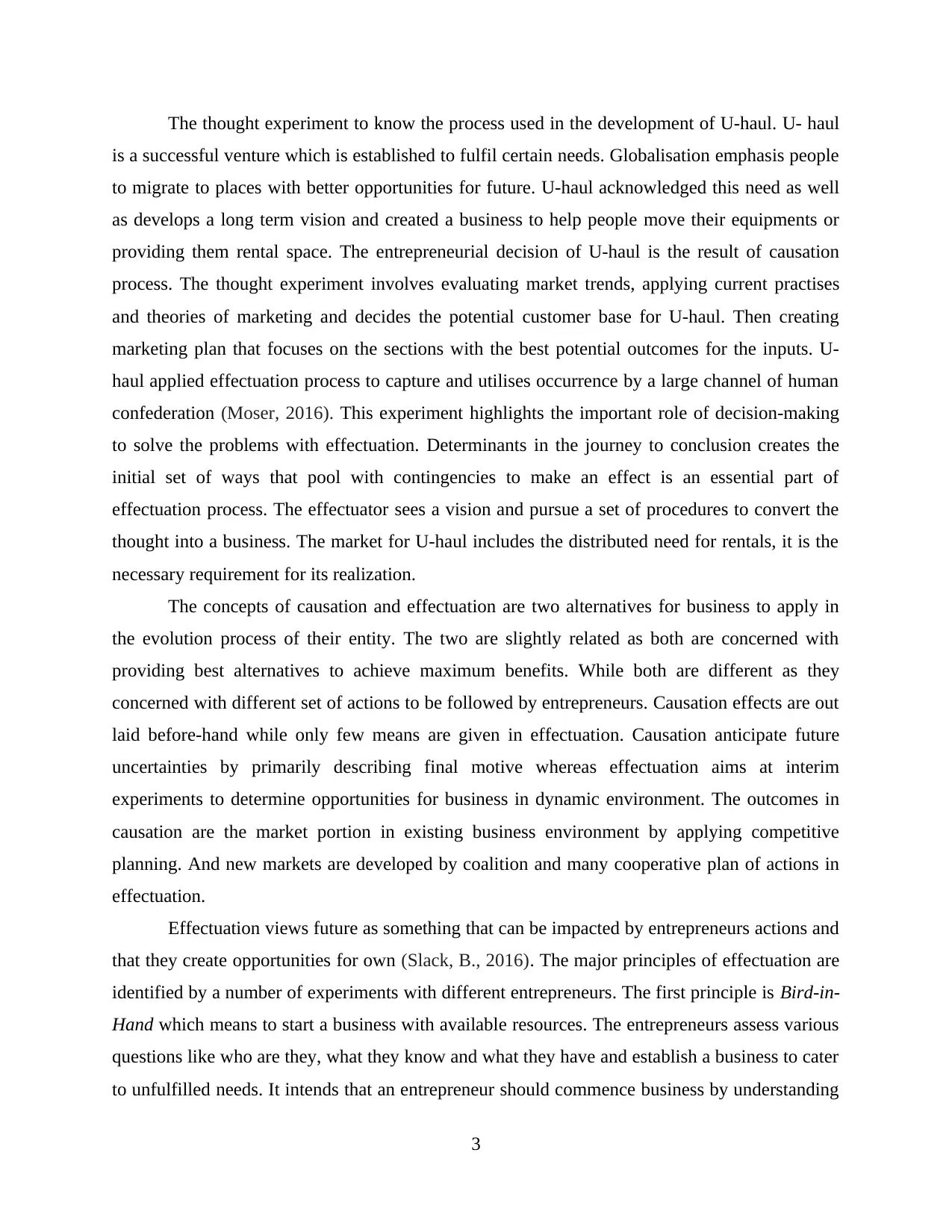
The thought experiment to know the process used in the development of U-haul. U- haul
is a successful venture which is established to fulfil certain needs. Globalisation emphasis people
to migrate to places with better opportunities for future. U-haul acknowledged this need as well
as develops a long term vision and created a business to help people move their equipments or
providing them rental space. The entrepreneurial decision of U-haul is the result of causation
process. The thought experiment involves evaluating market trends, applying current practises
and theories of marketing and decides the potential customer base for U-haul. Then creating
marketing plan that focuses on the sections with the best potential outcomes for the inputs. U-
haul applied effectuation process to capture and utilises occurrence by a large channel of human
confederation (Moser, 2016). This experiment highlights the important role of decision-making
to solve the problems with effectuation. Determinants in the journey to conclusion creates the
initial set of ways that pool with contingencies to make an effect is an essential part of
effectuation process. The effectuator sees a vision and pursue a set of procedures to convert the
thought into a business. The market for U-haul includes the distributed need for rentals, it is the
necessary requirement for its realization.
The concepts of causation and effectuation are two alternatives for business to apply in
the evolution process of their entity. The two are slightly related as both are concerned with
providing best alternatives to achieve maximum benefits. While both are different as they
concerned with different set of actions to be followed by entrepreneurs. Causation effects are out
laid before-hand while only few means are given in effectuation. Causation anticipate future
uncertainties by primarily describing final motive whereas effectuation aims at interim
experiments to determine opportunities for business in dynamic environment. The outcomes in
causation are the market portion in existing business environment by applying competitive
planning. And new markets are developed by coalition and many cooperative plan of actions in
effectuation.
Effectuation views future as something that can be impacted by entrepreneurs actions and
that they create opportunities for own (Slack, B., 2016). The major principles of effectuation are
identified by a number of experiments with different entrepreneurs. The first principle is Bird-in-
Hand which means to start a business with available resources. The entrepreneurs assess various
questions like who are they, what they know and what they have and establish a business to cater
to unfulfilled needs. It intends that an entrepreneur should commence business by understanding
3
is a successful venture which is established to fulfil certain needs. Globalisation emphasis people
to migrate to places with better opportunities for future. U-haul acknowledged this need as well
as develops a long term vision and created a business to help people move their equipments or
providing them rental space. The entrepreneurial decision of U-haul is the result of causation
process. The thought experiment involves evaluating market trends, applying current practises
and theories of marketing and decides the potential customer base for U-haul. Then creating
marketing plan that focuses on the sections with the best potential outcomes for the inputs. U-
haul applied effectuation process to capture and utilises occurrence by a large channel of human
confederation (Moser, 2016). This experiment highlights the important role of decision-making
to solve the problems with effectuation. Determinants in the journey to conclusion creates the
initial set of ways that pool with contingencies to make an effect is an essential part of
effectuation process. The effectuator sees a vision and pursue a set of procedures to convert the
thought into a business. The market for U-haul includes the distributed need for rentals, it is the
necessary requirement for its realization.
The concepts of causation and effectuation are two alternatives for business to apply in
the evolution process of their entity. The two are slightly related as both are concerned with
providing best alternatives to achieve maximum benefits. While both are different as they
concerned with different set of actions to be followed by entrepreneurs. Causation effects are out
laid before-hand while only few means are given in effectuation. Causation anticipate future
uncertainties by primarily describing final motive whereas effectuation aims at interim
experiments to determine opportunities for business in dynamic environment. The outcomes in
causation are the market portion in existing business environment by applying competitive
planning. And new markets are developed by coalition and many cooperative plan of actions in
effectuation.
Effectuation views future as something that can be impacted by entrepreneurs actions and
that they create opportunities for own (Slack, B., 2016). The major principles of effectuation are
identified by a number of experiments with different entrepreneurs. The first principle is Bird-in-
Hand which means to start a business with available resources. The entrepreneurs assess various
questions like who are they, what they know and what they have and establish a business to cater
to unfulfilled needs. It intends that an entrepreneur should commence business by understanding
3
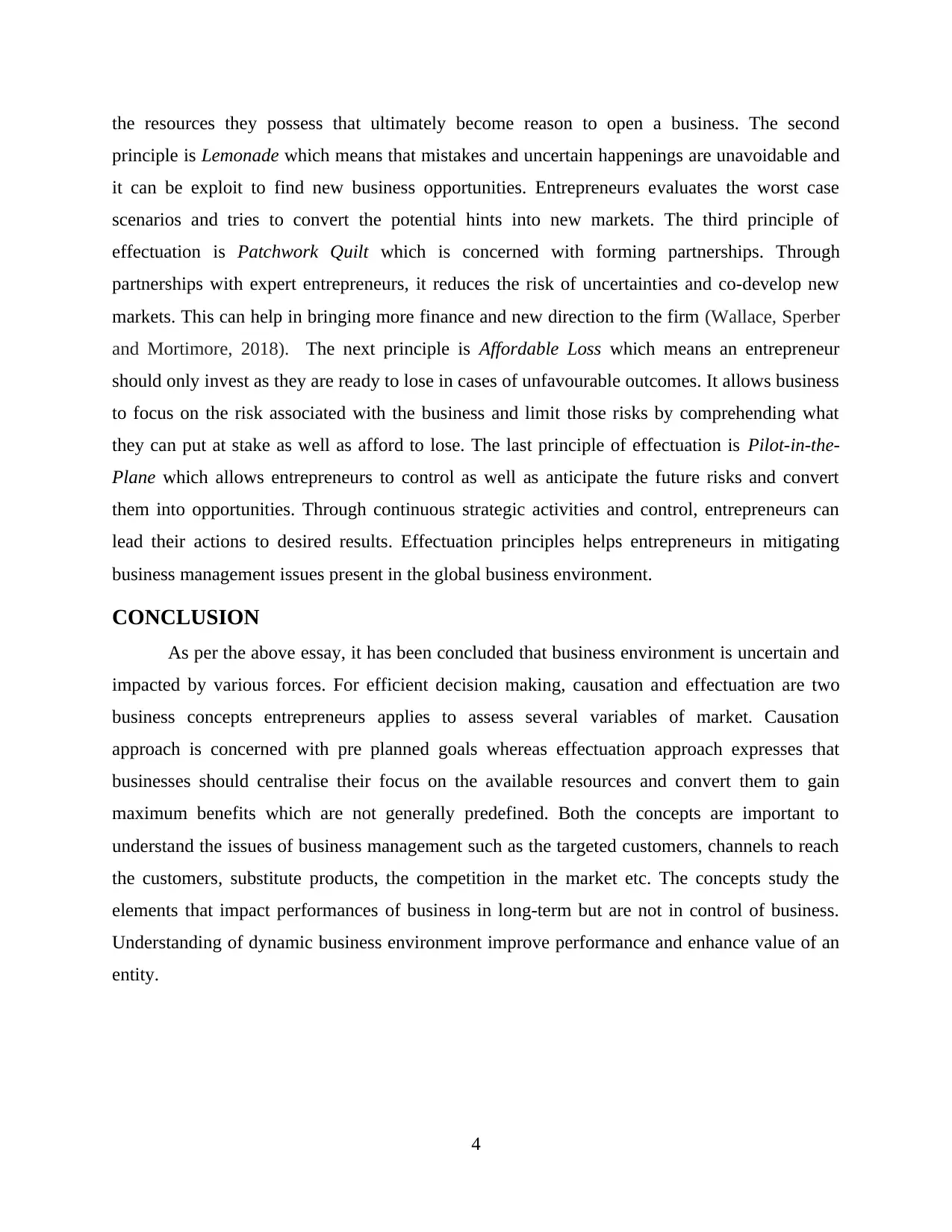
the resources they possess that ultimately become reason to open a business. The second
principle is Lemonade which means that mistakes and uncertain happenings are unavoidable and
it can be exploit to find new business opportunities. Entrepreneurs evaluates the worst case
scenarios and tries to convert the potential hints into new markets. The third principle of
effectuation is Patchwork Quilt which is concerned with forming partnerships. Through
partnerships with expert entrepreneurs, it reduces the risk of uncertainties and co-develop new
markets. This can help in bringing more finance and new direction to the firm (Wallace, Sperber
and Mortimore, 2018). The next principle is Affordable Loss which means an entrepreneur
should only invest as they are ready to lose in cases of unfavourable outcomes. It allows business
to focus on the risk associated with the business and limit those risks by comprehending what
they can put at stake as well as afford to lose. The last principle of effectuation is Pilot-in-the-
Plane which allows entrepreneurs to control as well as anticipate the future risks and convert
them into opportunities. Through continuous strategic activities and control, entrepreneurs can
lead their actions to desired results. Effectuation principles helps entrepreneurs in mitigating
business management issues present in the global business environment.
CONCLUSION
As per the above essay, it has been concluded that business environment is uncertain and
impacted by various forces. For efficient decision making, causation and effectuation are two
business concepts entrepreneurs applies to assess several variables of market. Causation
approach is concerned with pre planned goals whereas effectuation approach expresses that
businesses should centralise their focus on the available resources and convert them to gain
maximum benefits which are not generally predefined. Both the concepts are important to
understand the issues of business management such as the targeted customers, channels to reach
the customers, substitute products, the competition in the market etc. The concepts study the
elements that impact performances of business in long-term but are not in control of business.
Understanding of dynamic business environment improve performance and enhance value of an
entity.
4
principle is Lemonade which means that mistakes and uncertain happenings are unavoidable and
it can be exploit to find new business opportunities. Entrepreneurs evaluates the worst case
scenarios and tries to convert the potential hints into new markets. The third principle of
effectuation is Patchwork Quilt which is concerned with forming partnerships. Through
partnerships with expert entrepreneurs, it reduces the risk of uncertainties and co-develop new
markets. This can help in bringing more finance and new direction to the firm (Wallace, Sperber
and Mortimore, 2018). The next principle is Affordable Loss which means an entrepreneur
should only invest as they are ready to lose in cases of unfavourable outcomes. It allows business
to focus on the risk associated with the business and limit those risks by comprehending what
they can put at stake as well as afford to lose. The last principle of effectuation is Pilot-in-the-
Plane which allows entrepreneurs to control as well as anticipate the future risks and convert
them into opportunities. Through continuous strategic activities and control, entrepreneurs can
lead their actions to desired results. Effectuation principles helps entrepreneurs in mitigating
business management issues present in the global business environment.
CONCLUSION
As per the above essay, it has been concluded that business environment is uncertain and
impacted by various forces. For efficient decision making, causation and effectuation are two
business concepts entrepreneurs applies to assess several variables of market. Causation
approach is concerned with pre planned goals whereas effectuation approach expresses that
businesses should centralise their focus on the available resources and convert them to gain
maximum benefits which are not generally predefined. Both the concepts are important to
understand the issues of business management such as the targeted customers, channels to reach
the customers, substitute products, the competition in the market etc. The concepts study the
elements that impact performances of business in long-term but are not in control of business.
Understanding of dynamic business environment improve performance and enhance value of an
entity.
4
⊘ This is a preview!⊘
Do you want full access?
Subscribe today to unlock all pages.

Trusted by 1+ million students worldwide
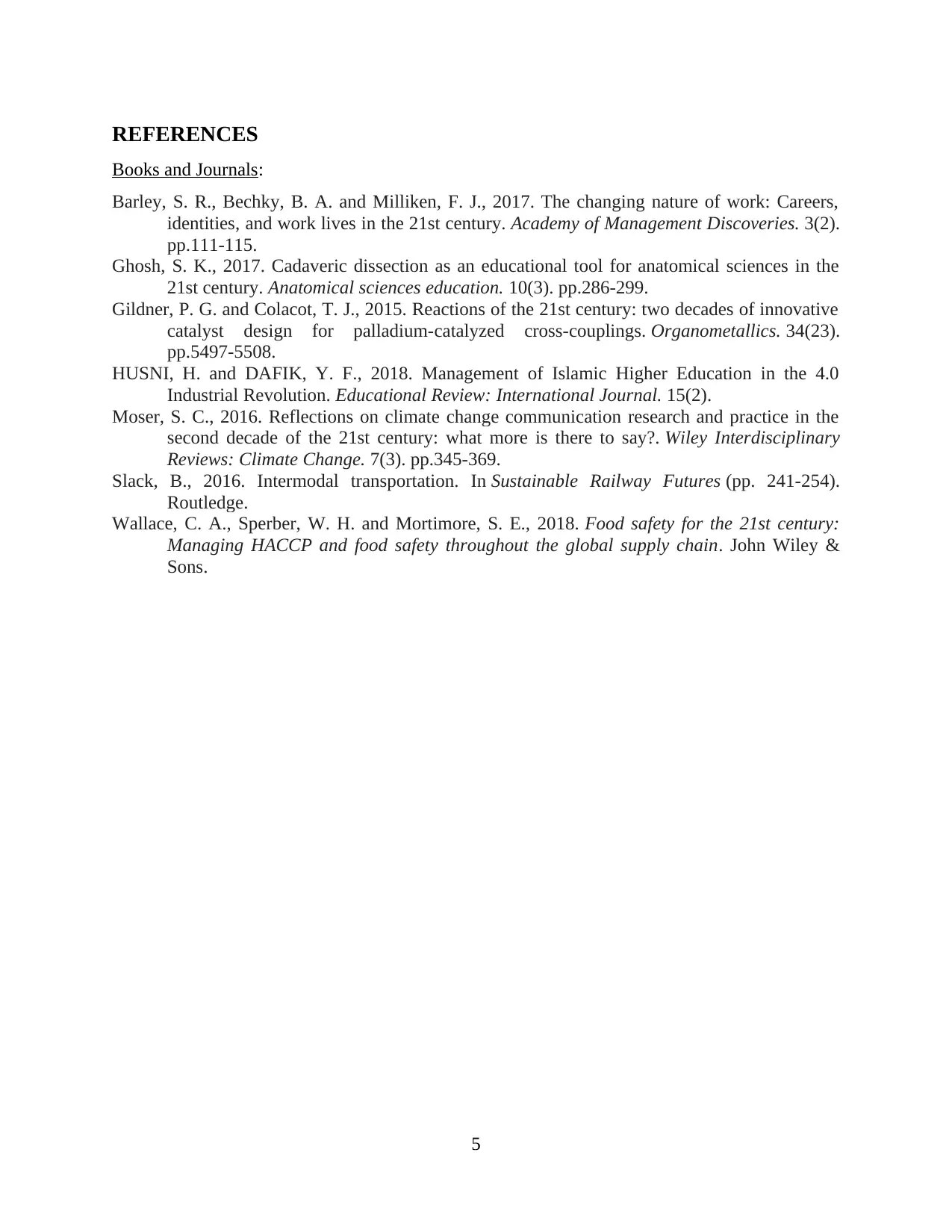
REFERENCES
Books and Journals:
Barley, S. R., Bechky, B. A. and Milliken, F. J., 2017. The changing nature of work: Careers,
identities, and work lives in the 21st century. Academy of Management Discoveries. 3(2).
pp.111-115.
Ghosh, S. K., 2017. Cadaveric dissection as an educational tool for anatomical sciences in the
21st century. Anatomical sciences education. 10(3). pp.286-299.
Gildner, P. G. and Colacot, T. J., 2015. Reactions of the 21st century: two decades of innovative
catalyst design for palladium-catalyzed cross-couplings. Organometallics. 34(23).
pp.5497-5508.
HUSNI, H. and DAFIK, Y. F., 2018. Management of Islamic Higher Education in the 4.0
Industrial Revolution. Educational Review: International Journal. 15(2).
Moser, S. C., 2016. Reflections on climate change communication research and practice in the
second decade of the 21st century: what more is there to say?. Wiley Interdisciplinary
Reviews: Climate Change. 7(3). pp.345-369.
Slack, B., 2016. Intermodal transportation. In Sustainable Railway Futures (pp. 241-254).
Routledge.
Wallace, C. A., Sperber, W. H. and Mortimore, S. E., 2018. Food safety for the 21st century:
Managing HACCP and food safety throughout the global supply chain. John Wiley &
Sons.
5
Books and Journals:
Barley, S. R., Bechky, B. A. and Milliken, F. J., 2017. The changing nature of work: Careers,
identities, and work lives in the 21st century. Academy of Management Discoveries. 3(2).
pp.111-115.
Ghosh, S. K., 2017. Cadaveric dissection as an educational tool for anatomical sciences in the
21st century. Anatomical sciences education. 10(3). pp.286-299.
Gildner, P. G. and Colacot, T. J., 2015. Reactions of the 21st century: two decades of innovative
catalyst design for palladium-catalyzed cross-couplings. Organometallics. 34(23).
pp.5497-5508.
HUSNI, H. and DAFIK, Y. F., 2018. Management of Islamic Higher Education in the 4.0
Industrial Revolution. Educational Review: International Journal. 15(2).
Moser, S. C., 2016. Reflections on climate change communication research and practice in the
second decade of the 21st century: what more is there to say?. Wiley Interdisciplinary
Reviews: Climate Change. 7(3). pp.345-369.
Slack, B., 2016. Intermodal transportation. In Sustainable Railway Futures (pp. 241-254).
Routledge.
Wallace, C. A., Sperber, W. H. and Mortimore, S. E., 2018. Food safety for the 21st century:
Managing HACCP and food safety throughout the global supply chain. John Wiley &
Sons.
5
1 out of 7
Related Documents
Your All-in-One AI-Powered Toolkit for Academic Success.
+13062052269
info@desklib.com
Available 24*7 on WhatsApp / Email
![[object Object]](/_next/static/media/star-bottom.7253800d.svg)
Unlock your academic potential
Copyright © 2020–2025 A2Z Services. All Rights Reserved. Developed and managed by ZUCOL.


